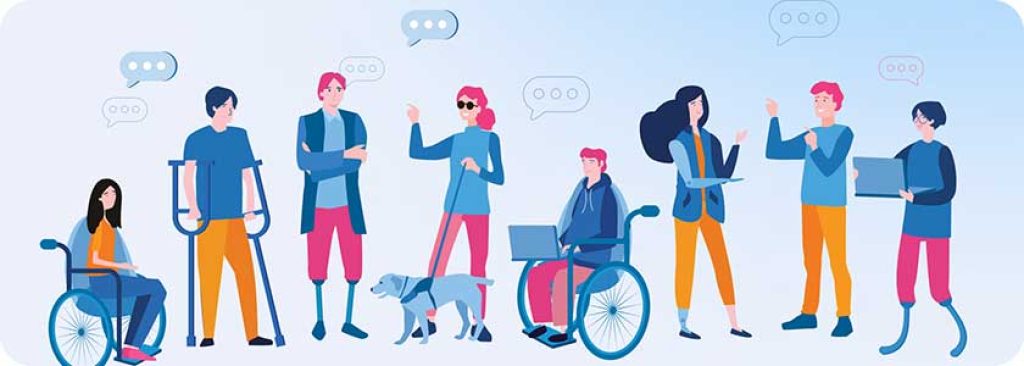Workplace Accessibility as a Foundation for Inclusivity
Are You Tapping Into the Power of Workplace Accessibility?
For employers who haven’t already made the smart move towards integrating inclusivity and accessibility, here’s a thought to consider: these factors are not only key motivators and productivity accelerators, but part of how you make your employees feel valued and understood.
Say, boss. Are you driven by a genuine sense of caring or by research revealing that happy workers show a 13% increase in productivity? It’s okay to admit it’s both: honesty works. In any case, it is very much worth your while to learn how you can attract and keep the best talent from the widest possible pool of workers. And once you’ve got that genius, you want to shut the door and hope they stay: a Gallup poll estimated that an organization may spend in the ballpark of 50% to 200% of an exiting employee’s annual salary to replace them. U.S. businesses are losing one trillion dollars per year due to absolutely unnecessary voluntary turnover: more than half of employees quitting of their own volition said that it could have been prevented, if management had talked to them and asked how they felt.

What is Workplace Accessibility?
Accessibility in its broadest sense refers to the removal of barriers that prevent individuals with disabilities from participating fully and equally in life's activities. Without accessibility accommodations, everyday interactions can become insurmountable obstacles. Under many disability rights laws in the U.S. and around the world, employers must provide equal opportunities for qualified individuals who have disabilities: that means accessibility.
Accessibility in the workplace refers to the design and practices of a work environment where individuals with disabilities can participate fully, equally and effectively in all aspects of employment. Physical accessibility covers barrier-free movement and interaction within the physical work arena. Digital accessibility guarantees employees equitable access to information and communication materials and technologies in formats they can use.
Some examples:
- Darla uses a wheelchair. Her workplace has ramps, accessible restrooms, and adapted workstations. The building’s doors and walkways meet standards for wheelchair access, so Darla can comfortably travel anywhere in the office, and she has an accessible parking space with room for her lift to open out. Her team understands that a lunch meeting might take longer for her, and that’s okay.
- Arjun is a software engineer. He is blind, and he’s new at his job. His company laptop has some adaptive tools as physical devices, and is also equipped with assistive software. There is Braille signage everywhere at work, but perhaps more importantly, his manager has arranged a tour of the workplace with him, and given him a chance to talk about what other adjustments might be helpful.
- Joy Lee has cancer. She had no idea that she is entitled to accessibility accommodations. She nearly lost her job because she did not explain that her tardies and absences were due to chemotherapy treatments, and she has been having trouble carrying packages onto her desk lately. Susan from Human Resources spoke with her, and Joy Lee now has a flexible schedule including hybrid and remote work, and an exemption from any lifting. Her teammates are very relieved that she can continue; they depend on her.

Why is Workplace Accessibility Important?
Aside from the clear ethical and legal obligations, accessibility in workplace contexts can offer significant benefits for both businesses and individuals with disabilities:
- Expands Talent Pool
Accessibility opens the door to skilled candidates with diverse backgrounds and abilities, increasing the bank of qualified candidates and creating a company culture that stimulates innovation. - Grows Employee Engagement
Inclusive workplaces with accessible features boast better employee morale, satisfaction, and productivity. - Reduces Costs Ahead
Kicking the can down the road means you’re headed for unfortunate surprises and sudden outlays. Addressing accessibility proactively lowers the future costs of corrective workplace modifications and legal non-compliance lawsuits or judgments. - Boosts Brand Perception
Commitment to accessibility demonstrates responsibility and attracts a wider, more loyal customer base.

Rules and Requirements for Accessibility in Offices
In the United States, The Americans with Disabilities Act (ADA) provides specific guidelines for creating accessible workplaces, both physically and digitally. The ADA requires all employers to provide reasonable accommodations that allow employees with disabilities to fully and independently perform their essential job functions.
While regulations vary by country and region, some general principles guide accessibility in office environments:
- Physical Accessibility
Offices must be physically accessible to all employees. This includes features such as:
- Accessible entrances, exits, and pathways, including access control systems
- Wheelchair-accessible workstations and meeting spaces
- Accessible restrooms and break rooms
- Assistive technology for doors, elevators, and lighting controls
- Effectively Accessible Information and Communication
- Accessible entrances, exits, and pathways, including access control systems
All employees must be able to access workplace communication and information both in person and using digital tools and platforms. This includes providing:
- Digital accessibility up to Web Content Accessibility Guidelines (WCAG) standards, including:
- Accessible digital documents and websites, with alternative text, screen reader compatibility, and functional keyboard navigation
- Closed captioning and transcripts for audio/video media and meetings
- Accessible workplace software, which may involve compatibility with screen readers, text-to-speech software, and other assistive technologies
- Adaptive workplace hardware as needed, such as scanners or Braille embossers
- Accessible digital documents and websites, with alternative text, screen reader compatibility, and functional keyboard navigation
- Assistive listening devices for conferences and presentations
- Interpreters and sign language interpreters in some situations
- Accessible Policies and Training
In all planning, policymaking and workplace interaction, care must be taken to consider and accommodate diverse needs and create a welcoming, inclusive environment:
- Flexible work arrangements and alternative communication methods must be offered
- Developing clear policies that promote accessibility and inclusivity is fundamental
- Frequently updated training for all employees on accessibility and inclusivity policies, as well as on overall disability awareness, can create a more supportive workplace culture
- Regular communication with employees and proactive identification of individual needs are crucial
- Emergency Preparedness
Offices must have emergency shelter and evacuation plans that account for the needs of all employees, including those with disabilities. This involves:
- Providing clear instructions that everyone can access and understand
- Planning and piloting accessible escape routes or evacuation to sheltered areas
- Assisting employees and colleagues with disabilities during emergency situations
Building an inclusive culture is an ongoing process. Developing an accessible workplace is a dynamic goal to constantly strive for, an aim that any organization can reach with a reasonable effort, but also an objective which must be continually cultivated, refined and redefined.
Remote Work and Accessibility: A New Frontier for Inclusion
The surge in remote and hybrid work arrangements has transformed the workplace landscape. While the flexibility and convenience can be game changers, this shift has not only redefined where work happens, it has highlighted the immediate need to activate and upgrade all work-related digital accessibility and adaptive options.
Remote work relies heavily on digital communication, collaboration and task management tools. If such tool functionalities and features are not offered in accessible ways, individuals with disabilities may be blocked from using them effectively, or at all. When these technologies are designed to be accessible to everyone, all employees can participate fully in work activities, regardless of their physical location or abilities.
Hybrid work models, which combine in-office and remote work to varying degrees, likewise underscore the importance of creating a seamlessly inclusive experience for employees. In an accessible, inclusive workplace, everyone has equal access to work opportunities, meetings, training, and work-centered social interactions, whether they take place at the office or online. Employees feel they belong, that their needs are not forgotten, and that their skills and their presence are appreciated. This makes people want to stay where they are and give their best.

Best Practices for Accessible Workplaces
Employers can create a more inclusive and accessible workplace by intentionally prioritizing these best practices:
- Accessibility Across Environments
The following best practices work for both digital and physical materials and communication channels: - Keep It Clear & Simple
Use direct, straightforward language, without heavy technical jargon, dramatic metaphors, or overused business buzzwords. Make sure that the message gets across to everyone. - Offer Different Data Formats
Media and collateral for any purpose should be provided in multiple formats, so that people with various disabilities can access them in a way that works for them. For example, if a meeting is audio-only, consider how you can offer a text-based option, like captions or transcripts, and whether that will serve the purpose in the circumstances. If a safety handout is given as printed sheets, be sure to include either an accessible PDF or a Braille version for employees with visual impairments. - Web & Digital Accessibility
In addition to any guidelines provided by your organization, follow these below:
- Learn & Follow WCAG
Make sure your websites, intranets, applications and software all adhere to Web Content Accessibility Guidelines (WCAG) for consistent accessibility across platforms and devices. - Add Appropriate Alt Text
Describe images and non-text content clearly using brief alternative text (alt text or alt tags) for screen readers and users with visual impairments. Don’t describe graphics or images that only act as visual flourishes, and do not serve any useful purpose (such as a blue sky background). - Optimize Keyboard Navigation
Design your website for intuitive navigation using only the keyboard, so that it is accessible to individuals with mobility limitations or visual impairments. - Check Color Contrast
Use colors that present an adequate contrast between text and background so that content is readable for all users, especially those with color blindness or visual impairments. - Design for Accessibility
Keep layouts clean, open, functional and logically structured. Set text as real text, not embedded in images. Use clear, sans-serif fonts with adjustable sizing and spacing for improved readability. - Provide Accessible PDFs
Use tools that create accessible PDFs with proper tagging, order and structure so that assistive technologies can navigate them effectively. - Utilize Video Accessibility Tools
Find good tools and services that offer captions and transcripts for both live and pre-recorded video materials. This makes content accessible to employees with hearing impairments, benefits those who prefer textual information, and as a bonus, leaves a written record that can be read later. - Use Proven Tools, Plugins, and Web Extensions
Equip your workforce with the necessary tools to complete their tasks efficiently and accessibly. Software that supports various disabilities improves workflow and productivity. Simulators like NoCoffee and others can help developers and designers visually grasp how users with color blindness will see their websites and digital documents. And digital accessibility testing, monitoring and web accessibility optimization tools can facilitate greater accessibility. - Assistive Technology Tools
Provide and utilize available tools, technologies, software and hardware to offer adaptive access, including:
- Screen Readers
The first line of access for people with visual disabilities and blindness, screen readers like JAWS and NVDA are a critical offering. They convert visual information into audio. - Text-to-Speech Tools
Although screen readers are a type of text to speech tool, they are far from the only option. Many tools can read text aloud in different contexts. - Speech Recognition Software
Speech-to-text tools like Dragon Naturally Speaking offer options for people with speech impairment or speech loss, mobility limitations, and cognitive disabilities to dictate text and commands. - Additional Accessibility Resources
These suggestions work in many contexts. Taking note of them can support employees in important ways. - Provide Assistive Technology Support
Offer assistance in acquiring and using relevant assistive technologies to remove barriers for employees. - Seek Employee Feedback
Regularly engage with employees with disabilities to identify specific needs and areas for improvement. - Promote Disability Awareness
Organize training sessions to educate all employees about accessibility. Raising awareness is a key step in creating an inclusive workplace culture.
- Screen Readers
- Learn & Follow WCAG

From Empathy to Excellence: Accessibility Equals Success
Beyond compliance, inclusion benefits everyone. It acts as a growth catalyst for any organization. It facilitates collaboration, strengthens engagement, bolsters morale, incubates innovation, and builds employee loyalty. In a place where all voices are heard and valued, potential can truly flourish. And that is a value driver that can’t be beat.
Individuals with unique experiences and abilities should be able to contribute equally, without environmental obstructions blocking their path forward. It’s only fair, and it is the law. It is the decent human thing to do, and although we may not find it easy at first, it becomes ingrained in our habits and practices when we make that our intention. And that desire to do things right is a natural part of all of us. It’s also entirely compatible with profit margins, and can be easily justified in any budget. Because it is that important, and allowing some empathy into corporate won’t harm it any. Accessibility is a critical part of building an inclusive workplace that respects everyone and allows for talents to bloom in unexpected ways. That’s the power of inclusion: it makes a space where everyone can thrive.
FAQs
Are accessibility changes expensive and time-consuming to implement?
Some could be. Many are not. A good percentage of accessibility practices are simple and cost-effective. Utilizing universal design principles from the outset can actually save costs in the long run. Government resources and tax incentives may also support accessibility initiatives.
How can small businesses implement workplace accessibility on a budget?
Start with small, impactful steps. Focus on high-priority areas like website accessibility and communication tools. Small businesses can also take cost-effective measures such as adopting flexible work policies. Utilize free resources and online guides to learn best practices. Partner with other businesses or community organizations to share resources and expertise. Training staff on inclusivity and accessibility awareness can also be done with minimal expense. All these actions move your business’s accessibility forward.
How can employers measure the success of their accessibility initiatives?
Success can be measured through employee satisfaction surveys, the rate of accommodation requests fulfilled, employee retention rates, and through feedback during performance reviews. Monitoring these metrics over time can provide insights into the effectiveness of accessibility efforts. And, for web and digital accessibility, testing tools and audits can offer transparency on the state of your organization’s accessibility.
Are there any incentives for businesses to improve workplace accessibility?
Yes. Some businesses may be eligible for tax incentives when they make accessibility improvements.
What role does employee feedback play in advancing workplace accessibility?
Employee feedback is key to identify gaps in current accessibility practices and to tailor solutions that directly address the unique needs of your workforce. Regular surveys and open communication channels facilitate this feedback.









